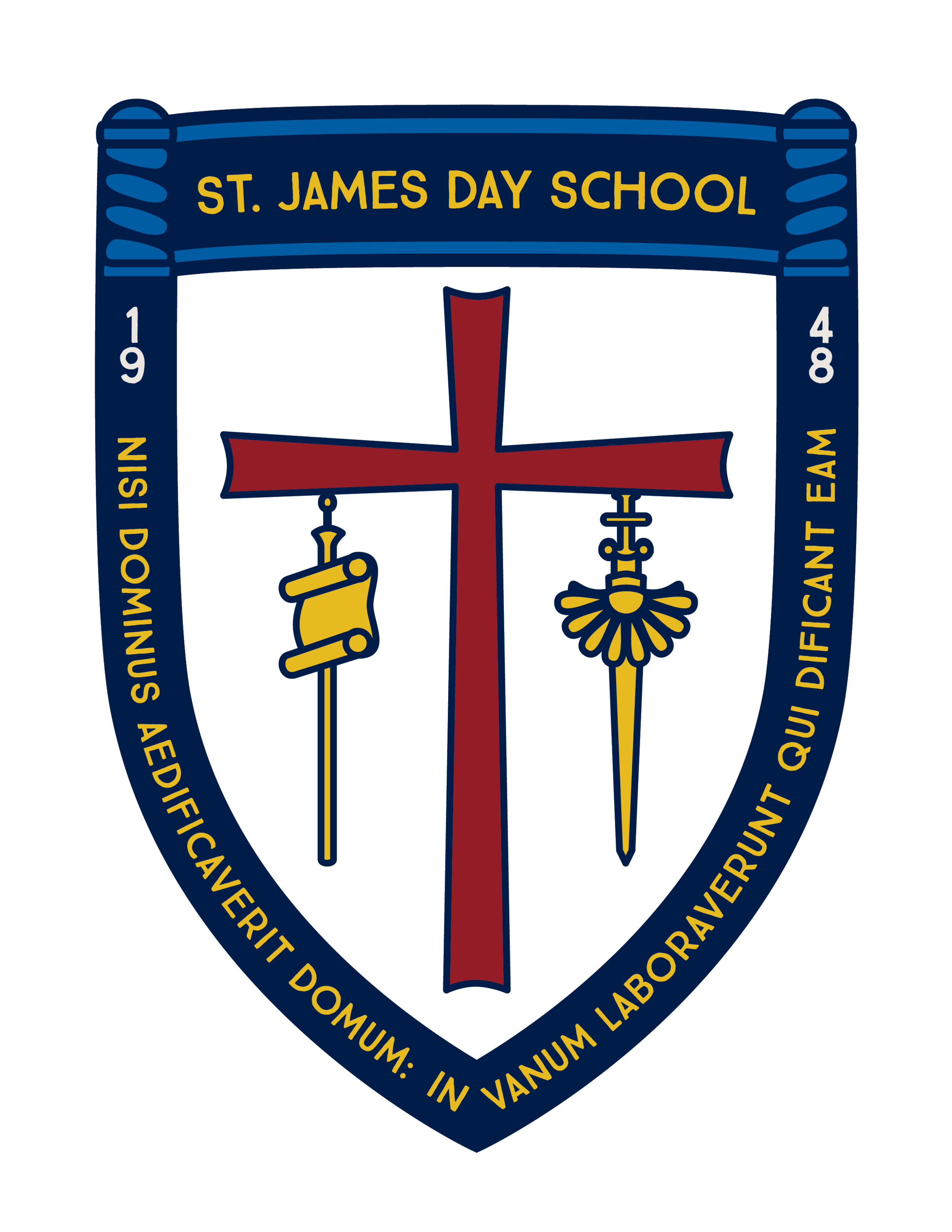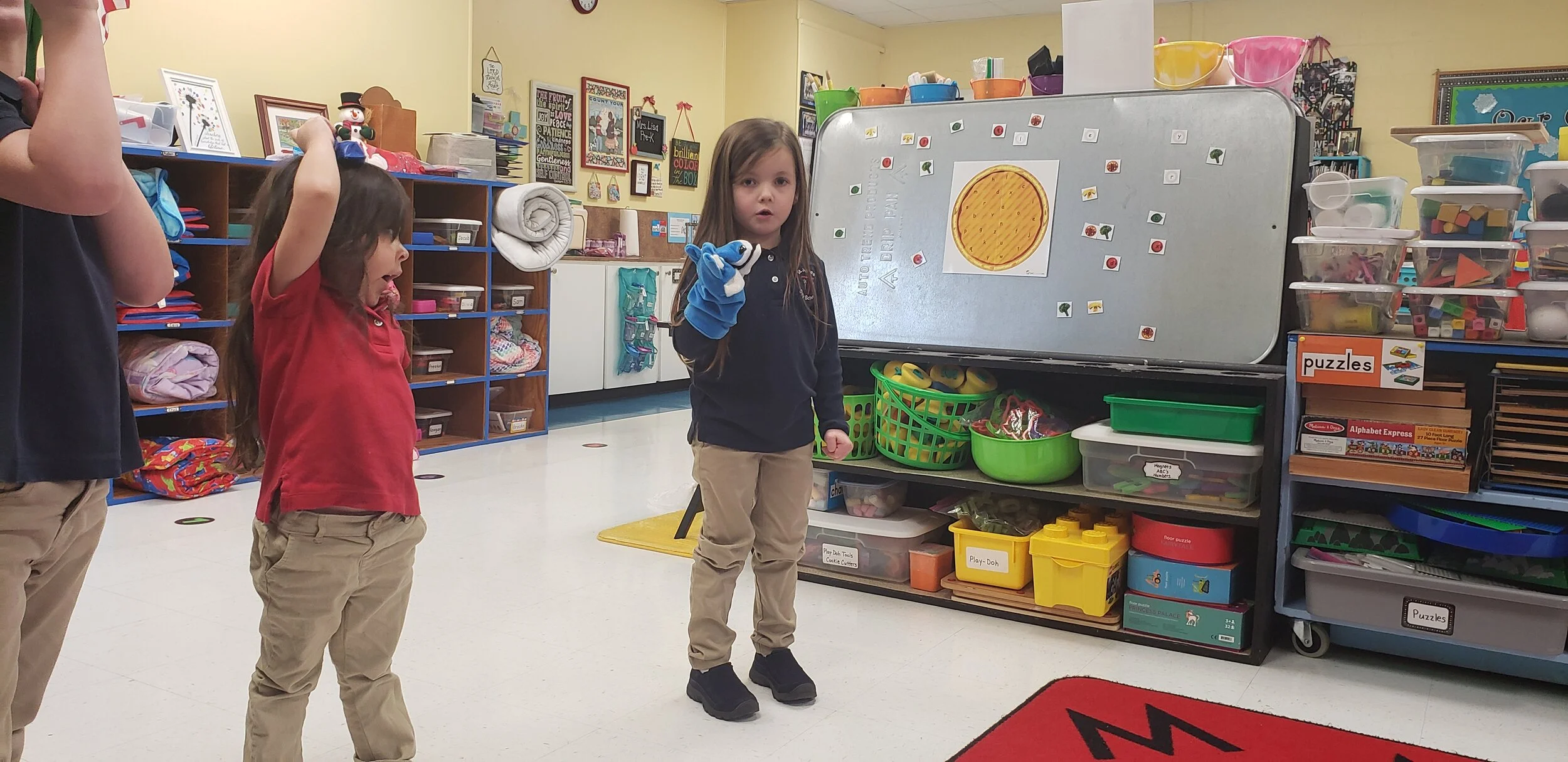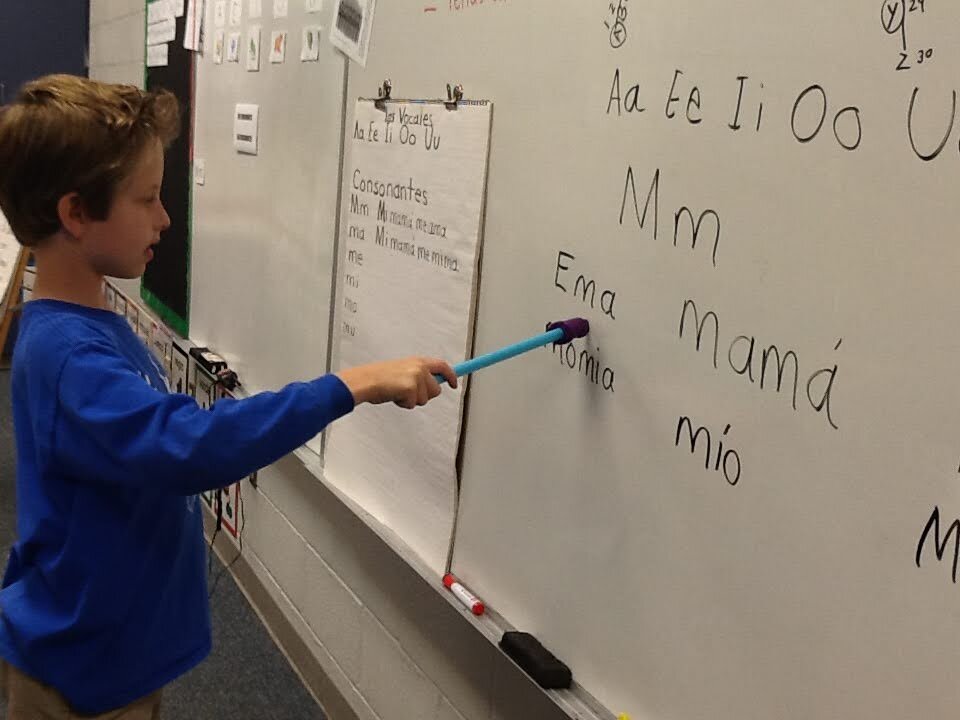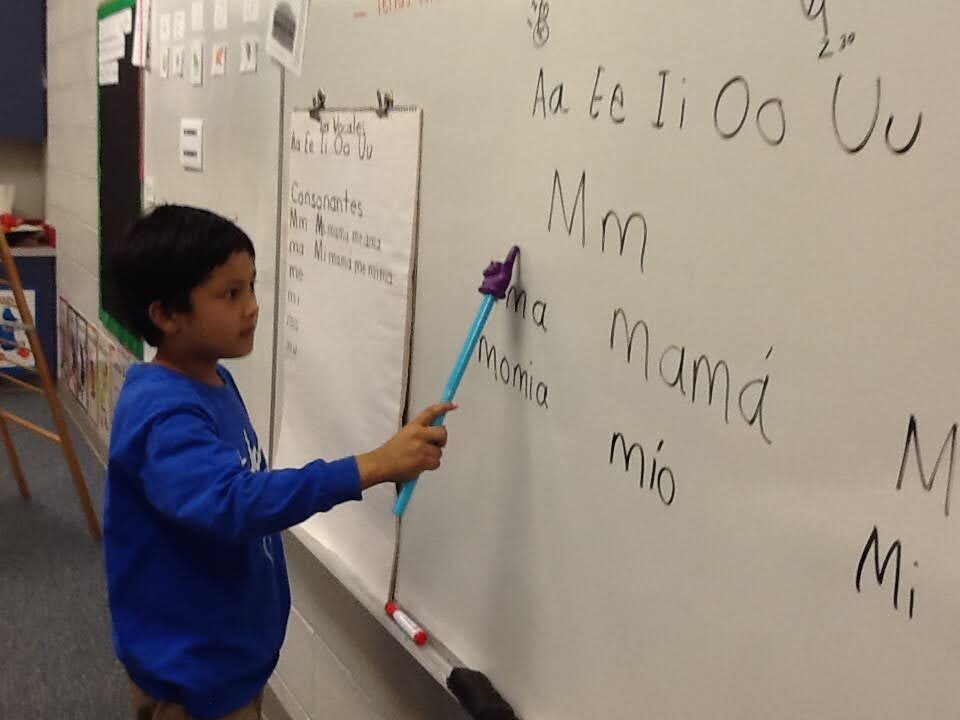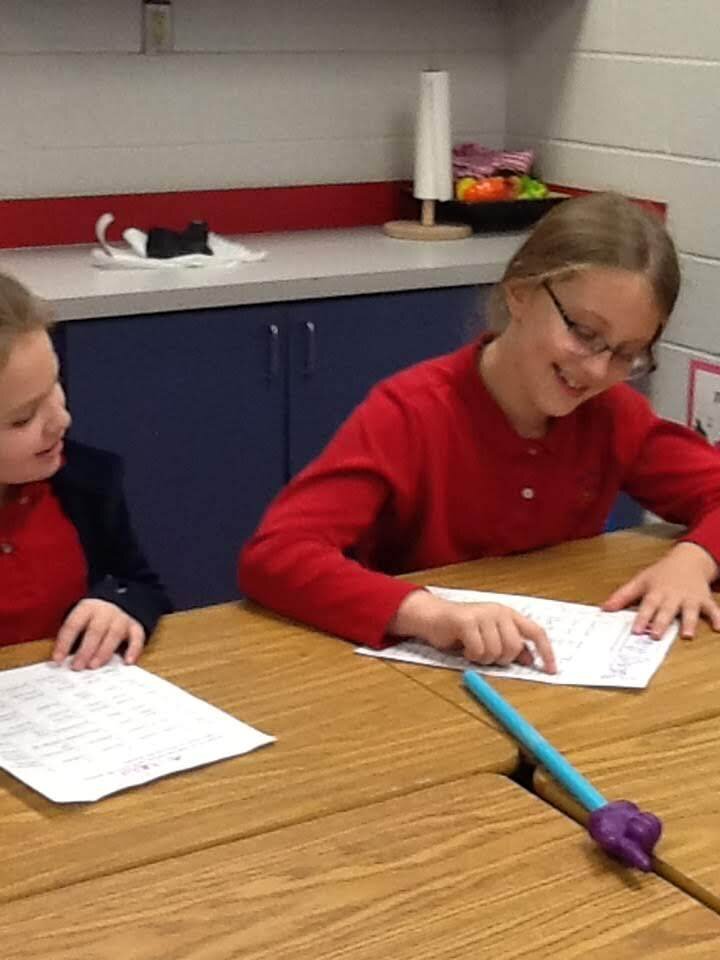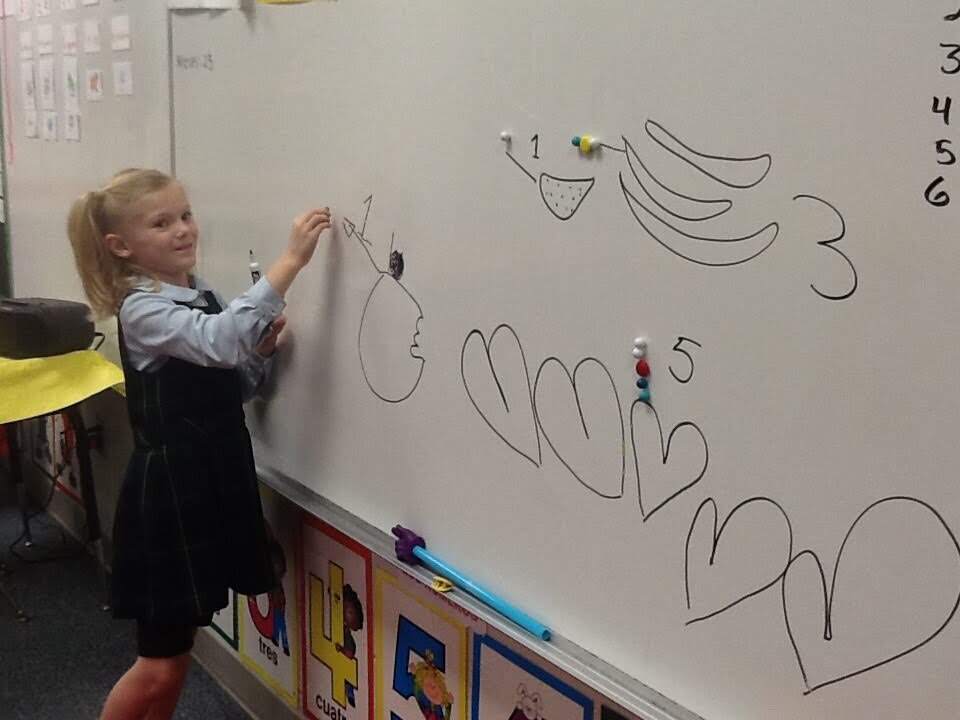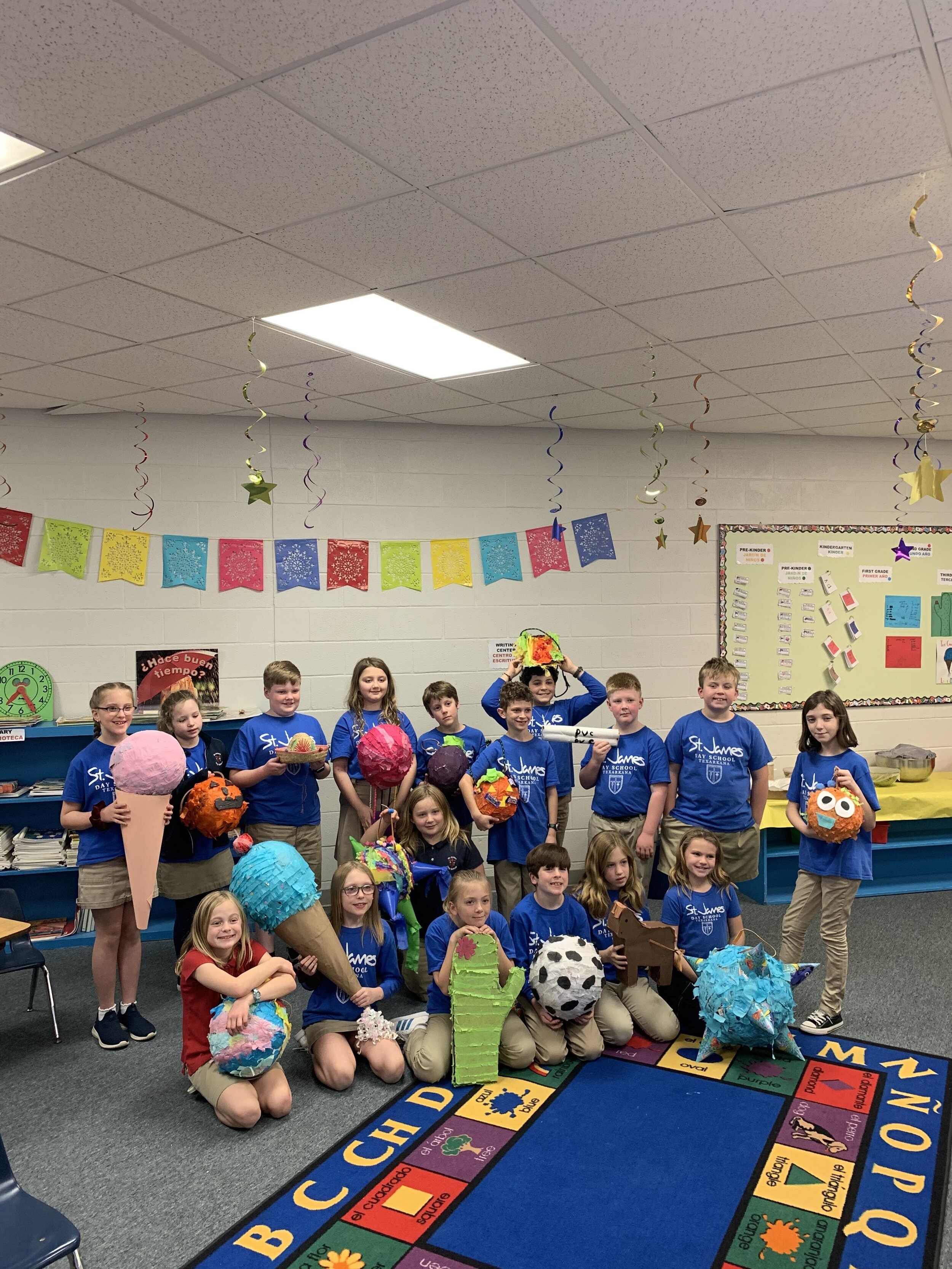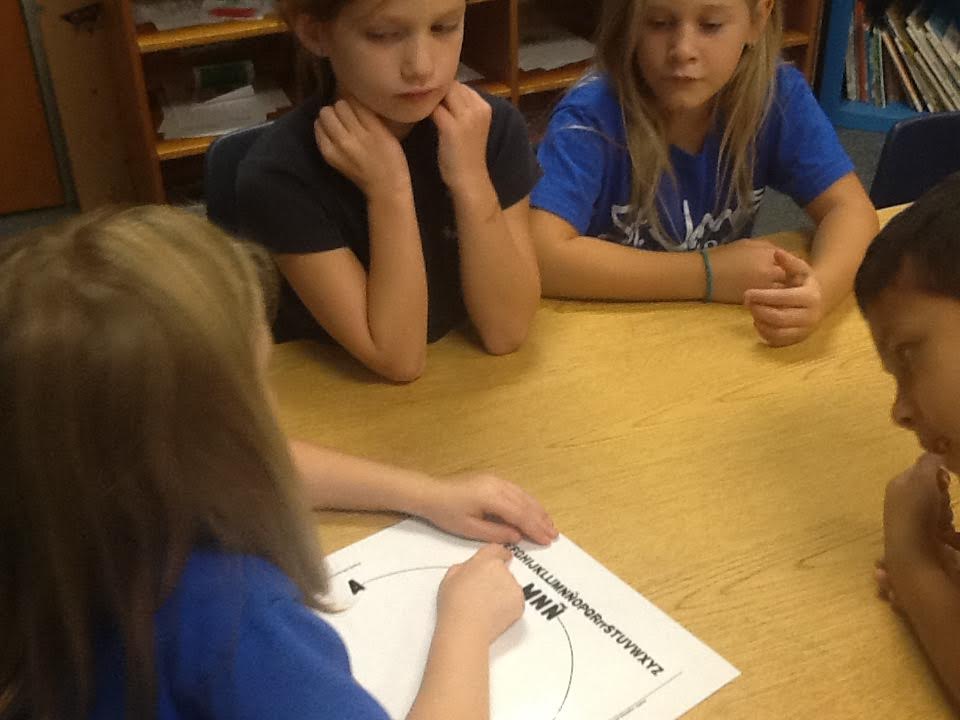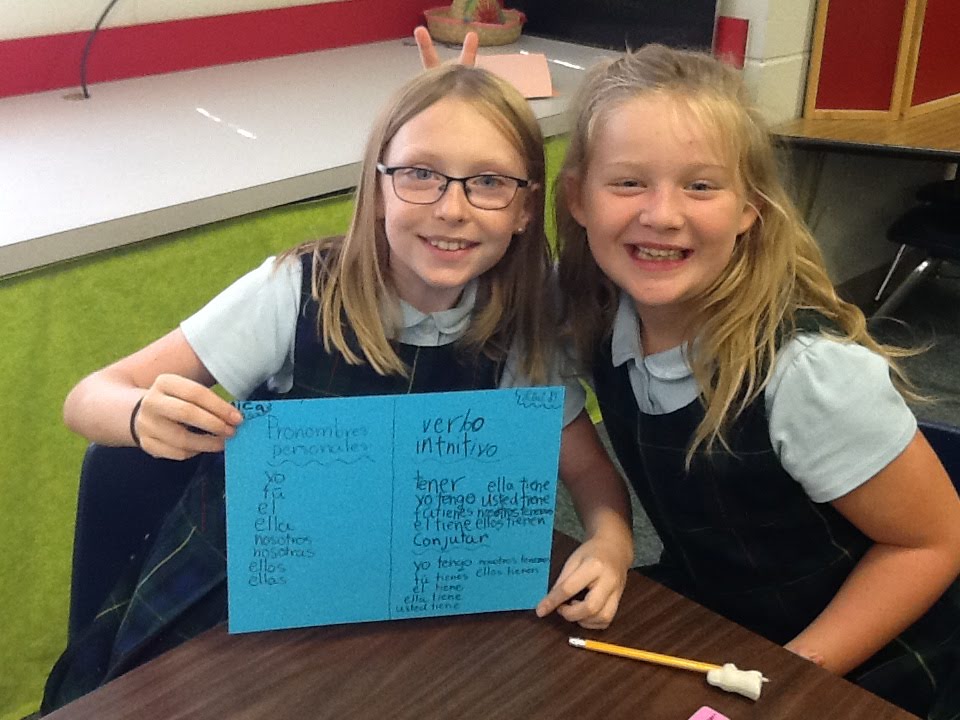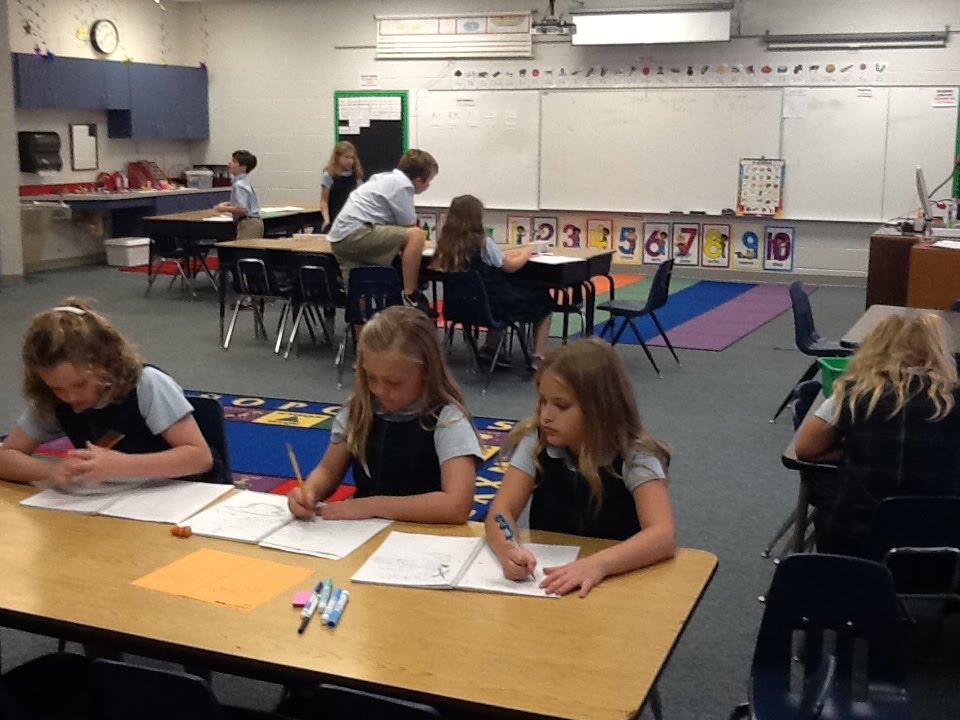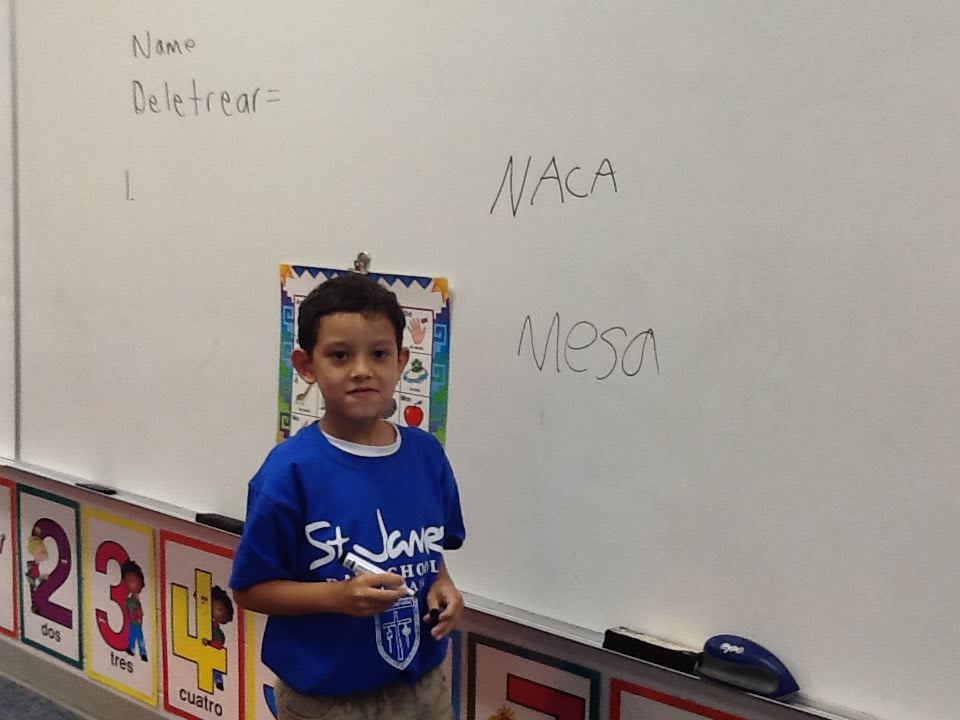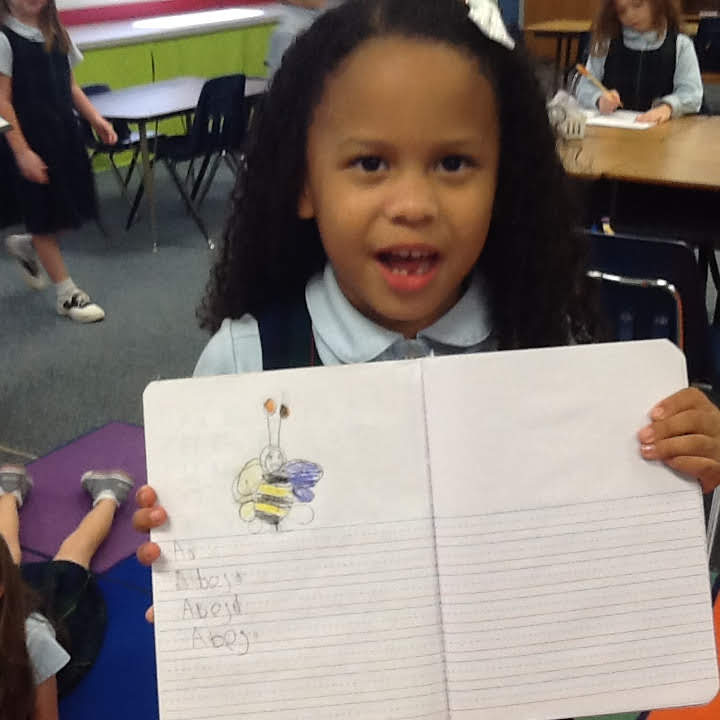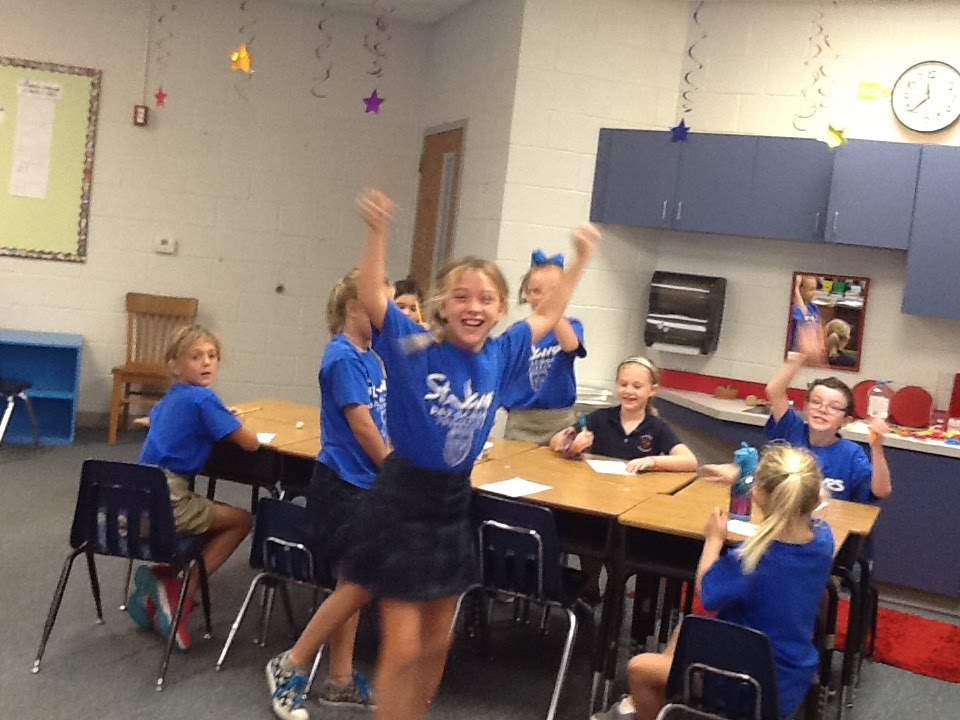The students are learning when to use the definite article (“the”) and indefinite articles (“a,” ”an,” and ”some”) in Spanish. To determine the correct Spanish article, students need to be able to determine if the corresponding noun is masculine or feminine. This process is usually a challenge to English-speaking students because English does not grammatically denote nouns as masculine or feminine. The definite article “the,” for example, might be the Spanish equivalent of “el,” “la,” “los,” or “las,” depending on whether the corresponding noun is masculine or feminine, singular or plural.
Body parts
The students are learning the body parts in Spanish. Students read, write and pronounce some body parts. They had so much fun practicing and drawing the body parts that they needed a larger piece of paper. After drawing a picture of a girl and a boy, they colored in the drawings and wrote in the names of the various body parts. They also learned a song about the body parts that they sang while they were drawings. The song goes like this…
cabeza, hombros, rodillas pies, rodillas y pies
ojos, orejas, boca y nariz,
cabeza, hombros, rodillas y pies, rodillas y pies.
espalda , pecho, piernas, cuello, pelo, barba, y frente, barba y frente,
Brazos, manos, dedos, uñas, lengua dientes, cejas y pestañas, cejas y pestañas.
Even though we are still working on the pronunciation, I am sure they will do fine.
The students are continuing learning the alphabet, numbers, sight words, shapes, and colors. One fun way to learn Spanish is through singing. Incorporating a puppet, students are learning a song in Spanish that lists different colors. Specifically, they learn the colors red (rojo), yellow (amarillo), green (verde), and blue (azul). The puppet I used is a blue wolf (un lobo azul). As part of the song, the students also learned the following phrases in Spanish: balloons for you (globos para ti), and my blue wolf (y mi lobo azul). They are having fun and learning too!
Today the students presented the project to their peers. When students were presented their piñatas, they explained how they made their piñatas. They listed and explained the materials they used. They also mentioned the new vocabulary that they learned in class, which included the Spanish words for certain foods. After the students finished presenting their piñatas, they enjoyed eating some Mexican food.
The following is a list of the materials and new vocabulary they learned in Spanish.
balloon-globo
newspaper-periódico
scissors-tijeras
cardboard-cartulina
glitter-brillantina
lanterns-linternas de papel
glue-pegamento
rope-cuerda
cake-pastel
meet-carne
pepper-jalapeno
apple-manzana
ice cream-helado
hamburger-hamburguesa
Cookie-galleta
limon-limón
For the last couple of weeks students have been working on a project to help them learn both Spanish and something about Hispanic culture. Here are some photos of students building piñatas from scratch. After students complete their projects in a couple of weeks they will present them in class to their fellow students. While they are working on their project they are also learning new vocabulary. For example, students using glue must remember the Spanish word for glue is pegamento.
Durante las últimas semanas, los estudiantes han estado trabajando con las manualidades de piñatas que les ayudará a aprender español y algo más sobre la cultura Hispana. En estas fotos podrán observar cómo los estudiantes están construyendo sus piñatas desde cero. Después que los estudiantes hayan completado sus piñatas estarán presentándolas a sus compañeros de clase en dos semanas. Mientras están trabajando en sus piñatas también están aprendiendo un nuevo vocabulario. Por ejemplo, los estudiantes están usando pegamento para completar sus piñatas el cual tienen que recordar que la palabra en inglés es glue.
Students have been learning new vocabulary that start with the “m”—words such as mano (hand), muñeca (doll), minero (miner), mono (monkey), mesa (table), mariposa (butterfly), moto (motorcycle), and manzana (apple). They have also learned how to count the syllables for each word, and this, in turn, helps them learn rules on how to pronounce words. Students then learned how to form simple sentences with the vocabulary they have learned.
Los estudiantes han estado aprendiendo palabras que empiezan con la letra “m”, palabras como mano, muñeca, minero, mono, mesa, mariposa, moto, y manzana. Ellos también están aprendiendo a como contar las sílabas en cada palabra. Y esto, asu vez, les ayuda a los estudiantes a aprender las reglas de como pronunciar las palabras nuevas. De esta forma, los estudiantes están aprendiendo a escribir oraciones.
The students of St. James Day School continue to learn Spanish in many different ways. This week we learned how to make some new sounds using the consonant M and the vowels. In this way, students are learning how to recognize syllables. They are also learning how to write short sentences.
Los estudiantes en St. James Day School siguen aprendiendo Español de diferentes formas. Esta semana aprendimos el nombre de la consonante M y su sonido, incluyendo las vocales. Así de esta forma, los estudiantes están aprendiendo a reconocer sílabas. Ellos también están aprendiendo cómo escribir oraciones cortas.
For the last couple of weeks, the students have been learning songs about colors, numbers, and letters. The students are continuing to learn how to count in Spanish, starting with the numbers zero through ten. We read small books and colored drawings. We are learning and having fun!
Las últimas semanas , los estudiantes han estado aprendiendo canciones sobre los colores, números, y letras. Los estudiantes continúan aprendiendo en Español los números del cero al diez. También hemos leído libritos y hemos coloreado dibujos. ¡Estamos aprendiendo y divirtiendonos!
The students and I began this school learning new rules due to COVID 19. Students then started to learn the Spanish alphabet, the letters and their sounds, the vowels, and the numbers 0-10. Students also learned how to recognize an infinitive verb and then how to conjugate it in the present tense.
Por el COVID 19, los estudiantes y yo empezamos el año escolar aprendien nuevas reglas. Los estudiantes empezaron a aprender el abecedarop, los nombre de las letras y sus sonidos, así como las vocales. También los estudiantes aprendieron a usar algunos verbos en infinitivo y aprendieron como usarlos a conjugarlos en tiempo presente.
Many Hispanic countries celebrate the Children’s Day on April 30th. This is why on this day, don’t miss the opportunity to say to your children how much you love them. Enjoy it the following pictures of your children. They are the future!
Happy Children’s Day!
El 30 de abril, se celebra en muchos países Hispanos el Día de los Niño. Por eso en este día, no mierdas la oportunidad de decirle a sus hijos cuánto los ama. Disfruten de las siguientes fotos de sus hijos. ¡Ellos son el futuro!
¡Feliz Día de los Niños!
Thank you, Parents and students
I would like to say a big “thank you” to parents and students at St. James Day School for keeping up with the homework. The following are some Spanish assignments that students have been working from home. They are great!
Thank you and stay safe.
Gracias, Padres y estudiantes,
Les quiero dar las gracias a los padres y los estudiantes de St. James Day School por eguir trabajando desde casa. Los siguientes son algunos ejemplos de los trabajos que los estudiantes han estado mandandome desde sus casa. Son excelente!
Thank you y mantenganse seguros.
Sight words! Sight words!
At the beginning of the semester, the students were instructed that they were responsible for reading 100 to 200 Spanish sight words by the end of the semester. The students can choose a variety of formats to study and learn the sight words in the classroom. For example, they can form small groups of around three students to practice their sight words or they can study on their own. The first and second graders should be able to identify and pronounce some 100 sight words by the end of the semester, while third and fourth graders must learn 200 sight words. The advantage of working in groups is that they learn to work with each other and practice together the pronunciation of the words they are learning. Also, learning together can be more fun.
¡Palabras de alta frecuencia! ¡Palabras de alta frecuencia!
Al principio del semestre, los estudiantes fueron instruidos que ellos eran responsible por aprender de a 100 a 200 palabras de alta frecuencia para a finales del semestre. Los estudiantes tienen la oportunidad de elegir una variedad de formas para estudiar y aprender las palabras de alta frecuencia en el salon. Por ejemplo, ellos pueden elegir formar grupos de dos a tres estudiantes para practicar las palabras de alta frecuencia, o pueden elegir estudiar solos si así lo desean. El primer y segundo grados deberían de identificar y pronunciar por lo menos 100 palabras de alta frecuencia para finales de semestre, mientras que el tercer y cuarto grados deberían de aprender 200 palabras de alta frecuencia. La ventaja de trabajar en grupos es que los estudiantes aprenden a trabajar juntos y con cada uno de ellos en practicar juntos la pronunciación de las palabras que están aprendiendo. También aprendiendo juntos puede ser más divertido.
The Body Parts:
The students learned to sing the song of the body parts.The song helps the students to pronounce and recognize the body parts in Spanish. The kids love it!
LasPpartes del Cuerpo:
Los estudiantes aprendieron a cantar la canción de las partes del cuerpo. La canción ayuda a los estudiantes a pronunciar y a reconocer las partes de cuerpo. ỉA los niños les encanta!
The Numbers!
The students are learning new vocabulary in Spanish. They are learning how to count the numbers in a sequence and are busy completing a variety of number-matching assignments. They also had fun coloring the one-hundred-days-of-school worksheet.
ỈLos Números!
Los estudiantes están aprendiendo un vocabulario nuevo en español. Los estudiantes están aprendiendo cómo contar los números en secuencia y así también están aprendiendo cómo contar los números y ponerlos en orden de acuerdo a su número correcto. Ellos han coloreado una hoja de recuerdo por los cien días de escuela y se divirtieron mucho.
Here at St James Day School, the students are continuing to learn about the culture and traditions of various Spanish countries. We started the New Year learning how some Latin American counties celebrated the arrival of the three wise men. In some Latin countries, such in Mexico, they celebrate the arrival of the three wise men and the cutting of the Wreath Bread (a round sweet bread) on January 6. The students learned that many Latin American children write letters to the three wise men asking for gifts the day before January 6. Students also learned that inside the bread are plastic figurines of baby Jesus. The adults cut the Wreath Bread and distribute the pieces to the children. A piece of bread that contains a baby Jesus inside means that that person has to prepare some food to share on the day of February 2, which is Candlemas Day (Día de la Candelaria).
St. James students had the opportunity to eat some sweet bread (do not worry the bread did not have a plastic baby Jesus inside) and drink some champurrado (hot chocolate). They also wrote letters to the wise men and colored some drawings of them.
We continue to have fun learning!
Los Tres Reyes Magos
En la Escuela de St. James, los estudiantes continúan aprendiendo un poco más acerce de la cultura y tradiciones de various paises Hispanohablantes. Empezamos el Año Nuevo aprendieno cómo en algunos paises Hispanohablantes se celebra la llegada de los Tres Reyes Magos. En algunos paises Hispanohablantes como en Mexico celebramos en enero 6, la llegada de los Tres Reyes Magos y partimos Rosca de Reyes. Los estudiantes han aprendido que los niños en Mexico escriben cartas un día antes del 6 de enero para pedir regalos a lost tres reyes magos. Los estudiantes también han aprendido que adentro de la rosca de reyes hay bebitos parecidos al niño Jesus. Los adultos cortan y reparten la rosca de reyes con los niños. Si en el pedazo de rosca se encuentra un niño Jesus esto significa que está persona tiene que preparer comida para compartir el 2 de febrero, el Día de la Candelaria.
Los estudiantes de St James han tenido la oportunidad de saboriar algunos pedazos de pan dulce (pero no se preocupen que el pan dulce no contenía los niñitos) junto con un chanpurrado calientito. También han podido escribir cartas a lost tres reyes magos y han coloreado algunos dibujos de ellos.
¡Continuamos diviertiendonos aprendiendo!
Project Piñatas:
The students in fourth and third grades are finally ready to show their piñatas to the class and parents. The students worked, learned, and had fun while making their piñatas and I am proud of these kids!
The students started this project by researching the type of piñata they wanted to make and how to make it. They then bought their materials needed to make their piñata. Lastly, they built their piñatas. They were required to write a few sentences describing how they did their work. The student made a wide variety of piñatas. Some of these piñatas include an ice cream on a cone, a disco ball, a pumpkin, stars, a horse, a hot-air balloon, a taco, a rainbow fish, a pear, and even a PVC pipe as piñatas.
Students learned Spanish vocabulary that corresponds to making a piñata—words such as globos, periódico, cuerda, papel de seda, pegamento, pompones, carton, cartulina, cinta adhesive, pegamento caliente, and pintura.
The students not only learned new vocabulary on how to make piñatas, but they also had fun working together. They discovered that it is possible to learn through play.
Proyecto Piñatas:
Los estudiante de cuarto y tercer grado finalmente están listo para mostrar sus piñatas a las compañeros de clase y a sus padres. ¡Los estudiantes trabajaron, aprendieron y se divirtieron mientras hacían sus piñatas y estoy muy orgullosa de estos niños!
Los estudiantes comenzaron este proyecto investigando el tipo de piñatas: que querían hacer y cómo hacerlo. Luego compraron los materiales necesarios para hacer sus piñatas. Por último construyeron sus piñatas. Se les pidió que escribieran algunas oraciones que describieran cómo hicieron sus trabajo piñatas. Los estudiantes tuvieron una variedad de tipos de piñatas las cuales incluyen helados en conos, una bola de discoteca, una calabaza, estrellas, un caballo, un globo aerostático, un taco, un pez de arcoiris, una pera, e incluso una pipa de PVC como piñatas.
Los estudiantes aprendieron vocabulario en Español que corresponde a hacer piñatas: palabras como globos, periódico, cuerda, papel de seda, pegamento, pompones, cartón, cartulina, cinta adhesiva, pegamento caliente y pintura.
Los estudiantes no solamente aprendieron un vocabulario nuevo sobre cómo hacer piñatas, sino que también se divirtieron trabajando juntos. Descubrieron que es posible aprender jugando.


The students at St James are learning how to write, read and spell words in Spanish. Some of these words are the names of the colors and shapes, as well as a variety of words we are learn day by day.
Los estudiantes de la Escuela de St. James están a aprendiendo a cómo escribir, a leer y a cómo escribir palabras correctamente. Algunas de las palabras son los nombres de los colores, formas, y palabras que vamos a aprendiendo día a día.





New vocabulary—Vocabulario Nuevo
The fourth grade students are learning new Spanish vocabulary. They are practicing much of this new vocabulary while making their favorite piñatas. Some of this vocabulary include words such as balloons, tape, newspaper, tissue paper, rope and cardboard.
Los estudiante de cuarto grado están aprendiendo un vocabulario nuevo en Español. Los estudiantes están aprendiendo a usar sus habilidades de cómo hacer sus piñatas favoritas de esa forma están aprendiendo a practicar las palabras nuevas como globos, cinta adhesive, periódico, cuerda, y cartulina.
The students at St James Day School are learning the names of the letters and the sounds of the alphabet in Spanish. They are learning how to identify vowels, write numbers, and know how to say different colors in Spanish. They are also learning the song La Marcha de las Vocales. Some students are learning how to spell out words, read sight words, and new vocabulary. Other students are learning how to write the short sentences in Spanish. They are using the personal pronouns to conjugate verbs in Spanish!
Los estudiantes de la escuela de St James están a aprendiendo las letras y sonidos del abecedario en Español. Los estudiantes están a aprendiendo a identificar las vocales, están a aprendiendo a escribir los números, y también están a aprendiendo como se dice los colores en Español. Los estudiantes están aprendiendo la canción La Marcha de las Vocales. Algunos estudiantes están a aprendiendo a deletrear y a leer palabras de alta frecuencia y palabras nuevas. Mientras tanto otros estudiantes están aprendiendo cómo escrbir pequeñas oraciones usando los pronombres personales para conjugar verbos en Español.
Hispanic Month
One reason September is known as the Hispanic month is because Mexican Independence Day is in September. Students are learning about the culture of Mexico and the names of some important people who made Mexican independence possible. The students are also learning about special days in Mexican calendar and learning how to make Mexican decorations. September 16 is Mexico’s Independence Day.
Mes de la Hispanidad
En septiembre hay una razón porque en Mexico se conoce cómo el Día de la Hispanidady porque se celebra el Día de la Independencia de Mexico. Los estudiantes de St James están aprendiendo sobre la cultura de Mexico, y nombre de personas importantes que hicieron posible la independencia. Los estudiantes también están aprendiendo sobre los días especiales y cómo hacer bonitas decoraciones. El 16 de septiembre es el Día de la Independencia de Mexico.
